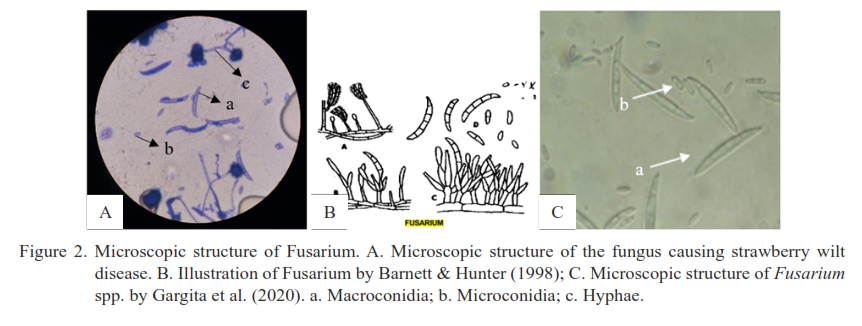Detection and identification of fungi causing strawberry wilt disease in North Sumatra, Indonesia
Main Article Content
Abstract
Strawberry (Fragaria sp.) is primarily grown in temperate and some subtropical countries. With the expansion of fruit commodities in Indonesia, including the introduction of foreign cultivar, strawberry has been increasingly cultivated locally. In North Sumatra, strawberry cultivation, mainly for agritourism, is concentrated in Karo Regency, Berastagi District. This study aimed to detect and identify fungi responsible for wilt disease in strawberry plants across several areas of Berastagi, North Sumatra. This research was conducted from July 2022 to May 2023 at the Plant Disease Laboratory, Faculty of Agriculture, Universitas Sumatera Utara. The study followed Koch’s postulates: the pathogen was isolated and purified from symptomatic plants, then inoculated into healthy plants. Infected plants exhibiting the same symptoms as the initial sample were subsequently re-isolated, purified, and identified at the molecular level. The results confirmed that the causal agent of wilt disease in Daulu (Rini Colia Strawberry, Esy Azera Strawberry) and Dolat Raya (Sonakmalela Strawberry, Alea Strawberry, Sembiring Gurky Strawberry) was Fusarium oxysporum.
Article Details

This work is licensed under a Creative Commons Attribution-NonCommercial 4.0 International License.
References
Afandi A, Masanto, Wibowo A, Afandi, Loekito S, Subandiyah S, Hieno A, Otsubo K, & Koji K. 2022. Molecular identification of oomycetes related to horticultural crops in Southern Sumatera and Java, Indonesia. J. Trop. Plant Pests Dis. 22(2): 90–99. https://doi.org/10.23960/jhptt.22290-99
Boba A, Kostyn K, Kozak B, Wojtasik W, Preisner M, Prescha A, Gola EM, Lysh D, Dudek B, Szopa J, & Kulma A. 2020. Fusarium oxysporum infection activates the plastidial branch of the terpenoid biosynthesis pathway in flax, leading to increased ABA synthesis. Planta. 251(2): 50. https://doi.org/10.1007/s00425-020-03339-9
Barnett HL & Hunter BB. 1998. Illustrated Genera of Imperfect Fungi, Fourth Edition. APS Press. St. Paul Minnesota.
Irjayanti AD, Wibowo AS, Sumartini NP, Nurfalah Z, Adani AD, Sijabat MS, Sitomorang N, Iman Q, Damayanti SR, & Putra YR. 2022. Statistics of Horticulture 2021. In: Setiawati R & Marpaung TH (Eds). Directorate of Food Crops, Horticulture and Estate Crops Statistics. BPS-Statistics Indonesia, Jakarta.
Gargita IWD, Wirya GNAS, & Sudiarta IP. 2020. Morphological confirmation of the fungi that causes strawberry wilt disease in Bali Indonesia. Jurnal Agroteknologi Tropika. 9(2): 132–138.
Henry PM, Kirkpatrick SC, Islas CM, Pastrana AM, Yoshisato JA, Koike ST, Daugovish O, & Gordon TR. 2017. The population of Fusarium oxysporum f.sp. fragariae, cause of Fusarium wilt of strawberry, in California. Plant Dis. 101(4): 550–556. https://doi.org/10.1094/PDIS-07-16-1058-RE
Huang XQ & Madan A. 1999. CAP3: A DNA sequence assembly program. Genome Res. 9: 868–877. https://doi.org/10.1101/gr.9.9.868
Koch R. 1982. The etiology of tuberculosis by Dr. Robert Koch. From the Berliner Klinische Wochenschrift, Volume 19 (1882). Zentralbl. Bakteriol. Mikrobiol. Hyg. A Med. Mikrobiol. Infekt. Parasitol. 251(3): 287–296.
Juber KS, Al-Juboory HH, & Al-Juboory SB. 2014. Fusarium wilt disease of strawberry caused by Fusarium oxysporum f.sp. fragariae in Iraq and its control. J. Exp. Biol. Agric. Sci. 2(4): 419–427. https://doi.org/10.13140/RG.2.2.35459.14889
Koike ST & Gordon TR. 2015. Management of Fusarium wilt of strawberry. Crop Prot. 73: 67–72. https://doi.org/10.1016/j.cropro.2015.02.003
Larkin MA, Blackshields G, Brown NP, Chenna R, McGettigan PA, McWilliam H, Valentin F, Wallace IM, Wilm A, Lopez R, Thompson JD, Gibson TJ, & Higgins DG. 2007. Clustal W and Clustal X version 2.0. Bioinformatics. 23(21): 2947–2948. https://doi.org/10.1093/bioinformatics/btm404
Leslie JF & Summerell BA. 2008. The Fusarium Laboratory Manual. https://doi.org/10.1002/9780470278376
Oktarina DO, Armaini, & Ardian. 2017. Pertumbuhan dan produksi stroberi (Fragaria sp.) dengan pemberian berbagai konsentrasi pupuk organik cair (POC) secara hidroponik substrat [Growth and production of strawberries (Fragaria sp.) with the application of various concentrations of liquid organic fertilizer (POC) in substrate hydroponics. JOM Faperta. 4(1): 1–12.
Prayudyaningsih R, Nursyamsi, & Sari R. 2015. Mikroorganisme tanah bermanfaat pada rhizosfer tanaman umbi di bawah tegakan hutan rakyat Sulawesi Selatan [Advantaging soil microorganism on the rhizosphere of tuber crop under the shade of community forest stand in South Sulawesi]. Pros. Sem. Nas. Masy. Biodiv. Indon. 1(4): 954–959.
Putra GWK, Ramona Y, & Proborini MW. 2020. Eksplorasi dan identifikasi mikroba yang diisolasi dari rhizosfer tanaman stroberi (Fragaria x ananassa Dutch.) di kawasan Pancasari Bedugul [Exploration and identification of microbes isolated from strawberry (Fragaria x ananassa Dutch.) rhizosphere in Pancasari Bedugul, Bali]. Metamorfosa: J. Biol. Sci. 7(2): 205–213. https://doi.org/10.24843/metamorfosa.2020.v07.i02.p09
Raja HA, Miller AN, Pearce CJ, & Oberlies NH, 2017. Fungal identification using molecular tools: A primer for the natural products research community. J. Nat. Prod. 80(3): 756–770. https://doi.org/10.1021/acs.jnatprod.6b01085
Saitou N & Nei M. 1983. The neighbor-joining method: A new method for reconstructing phylogenetic trees. Mol. Biol. Evol. 4(4): 406–425. https://doi.org/10.1093/oxfordjournals.molbev.a040454
Sari IGADV, Wirya GNAS, & Sudiarta IP. 2018. Identifikasi penyebab penyakit layu pada tanaman stroberi (Fragaria sp.) di Desa Pancasari dan potensi pengendaliannya dengan mikroba antagonis [Identification the causes of lute diseases in strawberry plants (Fragaria sp.) in Pancasari village and control potensial by microbial antagonists]. Jurnal Agroekoteknologi Tropika. 7(1): 103–112.
Snyder WC & Hansen HN. 1940. The species concept in Fusarium. Am. J. Bot. 27(2): 64–67. https://doi.org/10.2307/2436688
Tamura K, Stecher G, & Kumar S. 2021. MEGA11: Molecular evolutionary genetics analysis version 11. Mol. Biol. Evol. 38(7): 3022–3027. https://doi.org/10.1093/molbev/msab120
Thompson JD, Higgins DG, & Gibson TJ. 1994. CLUSTAL W: Improving the sensitivity of progressive multiple sequence alignment though sequence weighting, position?specific gap penalties and weight matrix choice. Nucleic Acids Res. 22(22): 4763–4680. https://doi.org/10.1093/nar/22.22.4673
Triasih U, Harsonowati W, Dwiastuti ME, & Widyaningsih S. 2023. Characterization of Fusarium wilt disease among different strawberry (Fragaria sp.) cultivars In Indonesia. IOP Conf. Ser. Earth Environ. Sci. (1287): 012022. https://doi.org/10.1088/1755-1315/1287/1/012022
White TJ, Bruns T, Lee S, & Taylor J. 1990. Amplification and direct sequencing of fungal ribosomal RNA genes for phylogenetics. In: Innis MA, Gelfand DH, Snisky JJ, & White TJ (Eds.). PCR Protocols: A Guide to Methods and Applications. pp. 315–322. Academic Press. New York.
Yadeta K & Thomma BPHJ. 2013. The xylem as battleground for plant hosts and vascular wilt pathogens. Front Plant Sci. 4: 97. https://doi.org/10.3389/fpls.2013.00097

